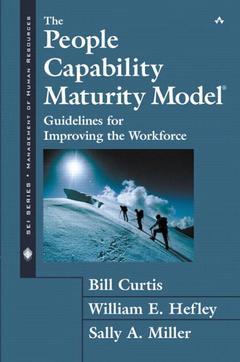The people capability maturity model : guidelines for improving the workforce
Auteurs : CURTIS Bill, HEFLEY William E., MILLER Sally A.

People Capability Maturity Model Framework.
Structure of This Book.
The Content of the People CMM.
Audience.
Feedback Information.
Acknowledgments.
I. THE PEOPLE CAPABILITY MATURITY MODEL: BACKGROUND, CONCEPTS, STRUCTURE, AND USAGE.
1. The Process Maturity Framework.Why Do We Need a People CMM?
What Is the Process Maturity Framework?
How Did the Process Maturity Framework Spread?
Why Did the People CMM Emerge in the Software Industry?
2. Overview of the People CMM.
Maturity Levels in the People CMM.
Behavioral Characteristics of Maturity Levels.
The Managed Level: Maturity Level 2.
The Defined Level: Maturity Level 3.
The Predictable Level: Maturity Level 4.
The Optimizing Level: Maturity Level 5.
3. People CMM Process Areas.
The Process Areas of the People CMM.
The Managed Level: Maturity Level 2.
The Defined Level: Maturity Level 3.
The Predictable Level: Maturity Level 4.
The Optimizing Level: Maturity Level 5.
Process Area Threads in the People CMM.
Building Workgroups and Culture.
Motivating and Managing Performance.
Shaping the Workforce.
4. The Architecture of the People CMM.
Maturity Levels.
Process Areas.
Goals.
Practices.
Institutionalization Practices.
Practice Statements.
Required, Expected, and Informative Components.
5. Interpreting the People CMM.
Goodness of Workforce Practices.
Interpreting the Practices.
Ability to Perform.
Practices Performed.
Measurement and Analysis.
Verifying Implementation.
Organizational Roles and Structure.
Organizational Structure.
Institutionalization Issues.
Defined, But Not Quantified or Optimized.
Maturity Level Concerns.
Level Fever.
Skipping Maturity Levels.
Ignoring Process Areas.
Implementing Practices Out of Maturity Level Sequence.
6. Using the People CMM.
The IDEAL Life Cycle Model for Improvement.
People CMM as a Guide for Improvement.
People CMM as a Basis for Assessments.
Joint Assessments.
Questionnaire-Based Assessments.
Gap Analyses.
Implementing a People CMM-Based Improvement Program.
Implementing Maturity-Based Improvement Programs.
7. Experience with the People CMM.
Benefits.
Case Studies.
Novo Nordisk IT A/S.
Lockheed Martin Mission Systems.
Tata Consulting Services.
Conclusion.
II. PROCESS AREAS OF THE PEOPLE CAPABILITY MATURITY MODEL.
The Managed Level: Maturity Level 2.
Communication and Coordination.
Work Environment.
Performance Management.
Training and Development.
Compensation.
The Defined Level: Maturity Level 3.
Workforce Pl
Introducing the P-CMM SM: a complete quality model for the 'human side' of software development.
- A clear, consistent framework for attracting, motivating, organizing, and retaining technical talent.
- Practical techniques for assessing and improving workforce practices.
- Communication, performance management, compensation, career development, knowledge analysis, mentoring, team building, continuous innovation, and much more.
Date de parution : 10-2001
Ouvrage de 586 p.
16.5x24 cm
